2009 PORSCHE PANAMERA lights
[x] Cancel search: lightsPage 208 of 343

206
Driving and Driving Safety
HOLD function: Drive-Off Assistant and
standstill management The HOLD function assists the driver when
stopping and driving off on upward slopes.
The vehicle is automatically prevented from rolling
back away from the desired direction of travel.
When the HOLD function is active, the function
light on the instrument panel lights up.
When adaptive cruise control is operating
normally, the HOLD function holds the vehicle
following automatic braking until the vehicle is
actively held in a stationary position.
Notes on operation
The HOLD function is no t available if the PDK
selector lever is in position N.
If the PDK selector lever is moved while the
HOLD function is active, the HOLD function is
deactivated.
If the driver’s seat be lt is unbuckled and the
driver’s door is opened wh ile the HOLD function is
active, the electric park ing brake is activated
automatically.
For information on the electric parking brake:
f Please see the chapter “ELECTRIC PARKING
BRAKE” on page 171.
Warning!
In spite of the advantages of the HOLD function, it
is still the driver’s responsibility to adapt his
driving style and maneuvers in line with road and
weather conditions, as well as the traffic situation.
The increased safety that is provided should not
induce you to take greate r risks with your safety.
Caution!
If the vehicle comes to a stop on a steep
uphill gradient without operation of the
footbrake by the driver, this may result in a
certain roll-back before the vehicle is held by
the HOLD function. In this situation, the roll-
back can be reduced by operating the
footbrake.
f Assist holding of the vehi cle by increasing the
brake force with the footbrake.
Brake pedal feels different. When adaptive
cruise control is operating normally or when
the HOLD function is active, the brake pedal
may feel different and you may hear
hydraulic noises.
This behavior is no rmal for the system.
It is not a fault.
Danger!
Risk of accidents. The limits set by physics of
driving cannot be overcome, even with HOLD
function. The responsibi lity for stopping and
driving off on uphill gradients is still the
driver’s, despite the HOLD function.
Assistance by the HOLD function is not
always guaranteed when stopping and
driving off on a slippery surface (e.g. on icy
or loose surfaces). In this case, the vehicle
can slip.
f Always adjust your driving style to the driving
conditions and vehicle load. Use the footbrake
if necessary.
If the Drive-Off Assistant is not functioning,
the driver cannot be assisted when driving
off on hills.
f Hold the vehicle with the footbrake.
Page 210 of 343
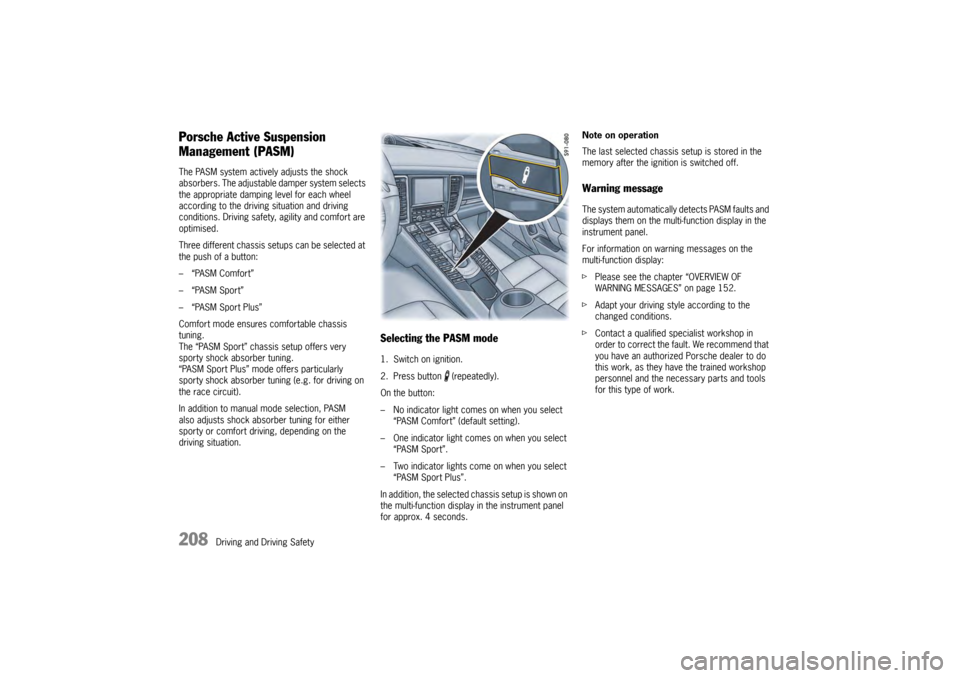
208
Driving and Driving Safety
Porsche Active Suspension
Management (PASM)The PASM system actively adjusts the shock
absorbers. The adjustable damper system selects
the appropriate damping level for each wheel
according to the driving situation and driving
conditions. Driving safety, agility and comfort are
optimised.
Three different chassis setu ps can be selected at
the push of a button:
– “PASM Comfort”
– “PASM Sport”
– “PASM Sport Plus”
Comfort mode ensures comfortable chassis
tuning.
The “PASM Sport” chassis setup offers very
sporty shock absorber tuning.
“PASM Sport Plus” mode offers particularly
sporty shock absorber tuning (e.g. for driving on
the race circuit).
In addition to manual mode selection, PASM
also adjusts shock absorber tuning for either
sporty or comfort driving, depending on the
driving situation.
Selecting the PASM mode1. Switch on ignition.
2. Press button (repeatedly).
On the button:
– No indicator light comes on when you select “PASM Comfort” (default setting).
– One indicator light come s on when you select
“PASM Sport”.
– Two indicator lights come on when you select “PASM Sport Plus”.
In addition, the selected chassis setup is shown on
the multi-function display in the instrument panel
for approx. 4 seconds. Note on operation
The last selected chassis setup is stored in the
memory after the ignition is switched off.
Warning messageThe system automatically
detects PASM faults and
displays them on the multi-function display in the
instrument panel.
For information on warning messages on the
multi-function display:
f Please see the chapter “OVERVIEW OF
WARNING MESSAGES” on page 152.
f Adapt your driving style according to the
changed conditions.
f Contact a qualified specialist workshop in
order to correct the fault. We recommend that
you have an authorized Porsche dealer to do
this work, as they have the trained workshop
personnel and the necessary parts and tools
for this type of work.
Page 211 of 343
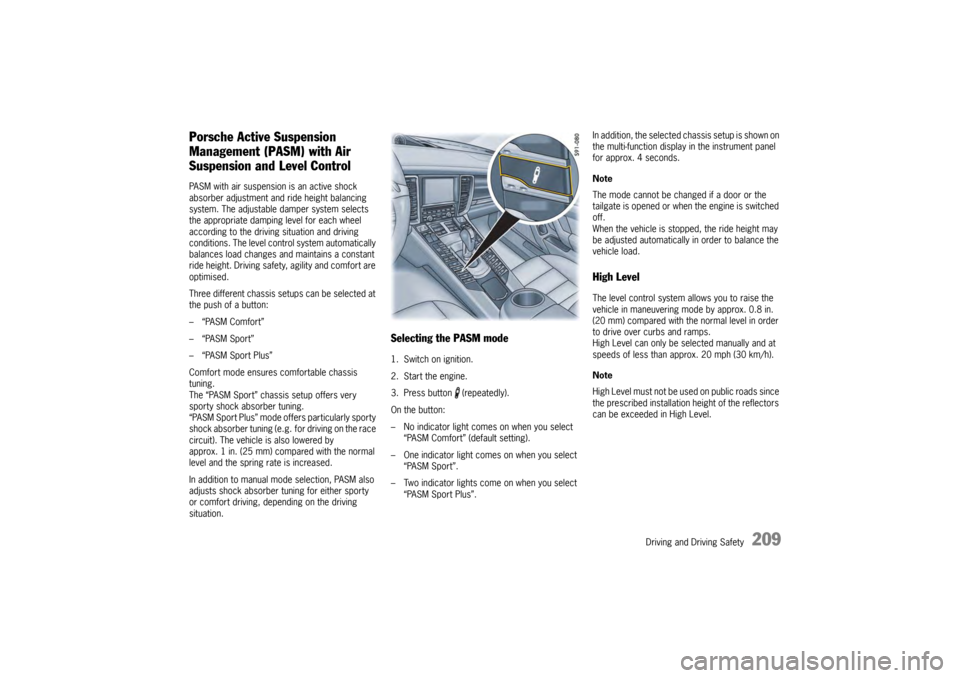
Driving and Driving Safety
209
Porsche Active Suspension
Management (PASM) with Air
Suspension and Level ControlPASM with air suspension is an active shock
absorber adjustment and ride height balancing
system. The adjustable damper system selects
the appropriate damping level for each wheel
according to the driving situation and driving
conditions. The level control system automatically
balances load changes and maintains a constant
ride height. Driving safety , agility and comfort are
optimised.
Three different chassis setups can be selected at
the push of a button:
– “PASM Comfort”
– “PASM Sport”
– “PASM Sport Plus”
Comfort mode ensures comfortable chassis
tuning.
The “PASM Sport” chassis setup offers very
sporty shock absorber tuning.
“PASM Sport Plus” mode offers particularly sporty
shock absorber tuning (e.g. for driving on the race
circuit). The vehicle is also lowered by
approx. 1 in. (25 mm) compared with the normal
level and the spring rate is increased.
In addition to manual mode selection, PASM also
adjusts shock absorber tuning for either sporty
or comfort driving, depending on the driving
situation.
Selecting the PASM mode1. Switch on ignition.
2. Start the engine.
3. Press button (repeatedly).
On the button:
– No indicator light come s on when you select
“PASM Comfort” (default setting).
– One indicator light comes on when you select “PASM Sport”.
– Two indicator lights come on when you select
“PASM Sport Plus”. In addition, the selected chassis setup is shown on
the multi-function display in the instrument panel
for approx. 4 seconds.
Note
The mode cannot be changed if a door or the
tailgate is opened or when the engine is switched
off.
When the vehicle is stopped, the ride height may
be adjusted automatically
in order to balance the
vehicle load.
High LevelThe level control system al lows you to raise the
vehicle in maneuvering mode by approx. 0.8 in.
(20 mm) compared with the normal level in order
to drive over curbs and ramps.
High Level can only be selected manually and at
speeds of less than approx. 20 mph (30 km/h).
Note
High Level must not be us ed on public roads since
the prescribed installation height of the reflectors
can be exceeded in High Level.
Page 212 of 343
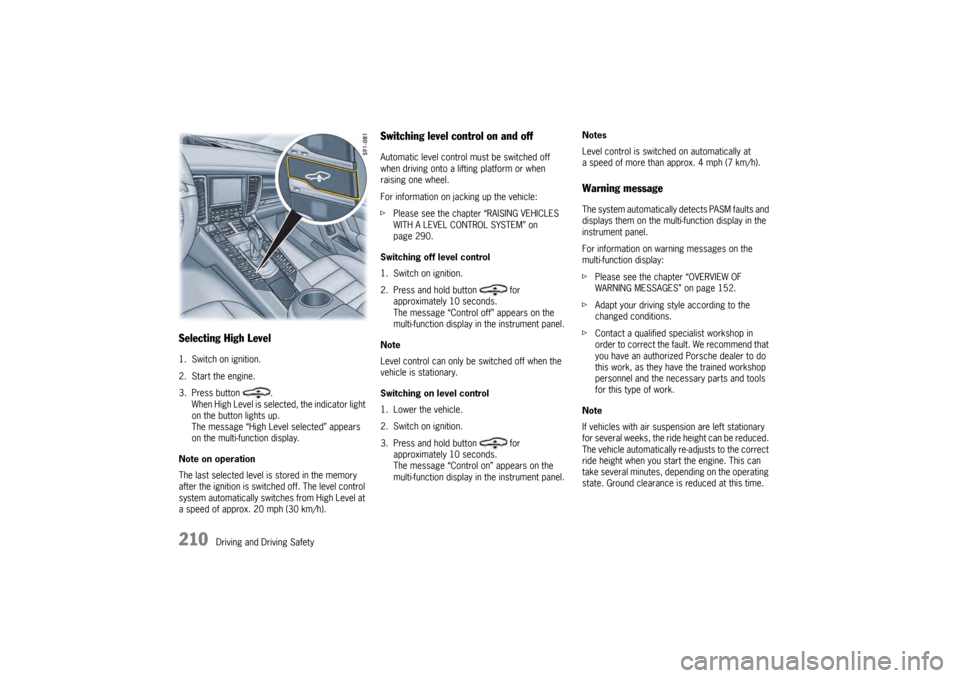
210
Driving and Driving Safety
Selecting High Level1. Switch on ignition.
2. Start the engine.
3. Press button .When High Level is selected, the indicator light
on the button lights up.
The message “High Level selected” appears
on the multi-function display.
Note on operation
The last selected level is stored in the memory
after the ignition is switched off. The level control
system automatically switches from High Level at
a speed of approx. 20 mph (30 km/h).
Switching level control on and offAutomatic level control must be switched off
when driving onto a lifting platform or when
raising one wheel.
For information on ja cking up the vehicle:
f Please see the chapter “RAISING VEHICLES
WITH A LEVEL CONTROL SYSTEM” on
page 290.
Switching off level control
1. Switch on ignition.
2. Press and hold button for approximately 10 seconds.
The message “Control off” appears on the
multi-function display in the instrument panel.
Note
Level control can only be switched off when the
vehicle is stationary.
Switching on level control
1. Lower the vehicle.
2. Switch on ignition.
3. Press and hold button for approximately 10 seconds.
The message “Control on” appears on the
multi-function display in the instrument panel. Notes
Level control is switched on automatically at
a speed of more than approx. 4 mph (7 km/h).
Warning messageThe system automatically
detects PASM faults and
displays them on the multi-function display in the
instrument panel.
For information on warning messages on the
multi-function display:
f Please see the chapter “OVERVIEW OF
WARNING MESSAGES” on page 152.
f Adapt your driving style according to the
changed conditions.
f Contact a qualified specialist workshop in
order to correct the fault. We recommend that
you have an authorized Porsche dealer to do
this work, as they have the trained workshop
personnel and the necessary parts and tools
for this type of work.
Note
If vehicles with air suspension are left stationary
for several weeks, the ride height can be reduced.
The vehicle automatically re-adjusts to the correct
ride height when you start the engine. This can
take several minutes, depending on the operating
state. Ground clearance is reduced at this time.
Page 215 of 343
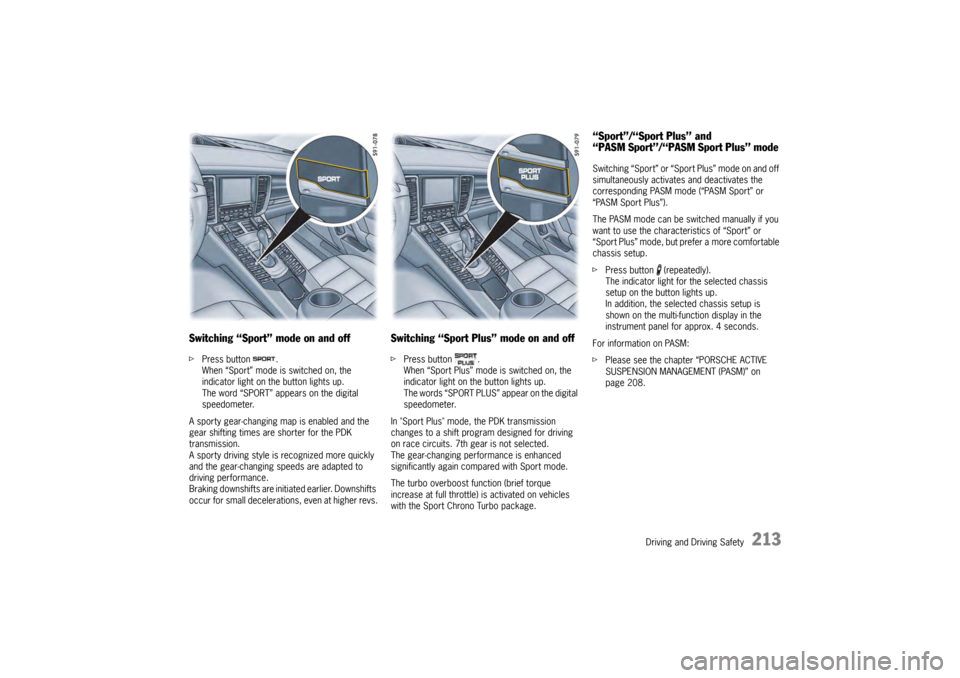
Driving and Driving Safety
213
Switching “Sport” mode on and offfPress button .
When “Sport” mode is switched on, the
indicator light on the button lights up.
The word “SPORT” appears on the digital
speedometer.
A sporty gear-changing map is enabled and the
gear shifting times ar e shorter for the PDK
transmission.
A sporty driving style is recognized more quickly
and the gear-changing speeds are adapted to
driving performance.
Braking downshifts are initiated earlier. Downshifts
occur for small decelerations, even at higher revs.
Switching “Sport Plus” mode on and offf Press button .
When “Sport Plus” mode is switched on, the
indicator light on the button lights up.
The words “SPORT PLUS” appear on the digital
speedometer.
In "Sport Plus" mode, the PDK transmission
changes to a shift progra m designed for driving
on race circuits. 7th gear is not selected.
The gear-changing performance is enhanced
significantly again compared with Sport mode.
The turbo overboost function (brief torque
increase at full throttle) is activated on vehicles
with the Sport Chrono Turbo package.
“Sport”/“Sport Plus” and
“PASM Sport”/“PASM Sport Plus” mode Switching “Sport” or “Sport Plus” mode on and off
simultaneously activates and deactivates the
corresponding PASM mode (“PASM Sport” or
“PASM Sport Plus”).
The PASM mode can be sw itched manually if you
want to use the characteristics of “Sport” or
“Sport Plus” mode, but prefer a more comfortable
chassis setup.
f Press button (repeatedly).
The indicator light for the selected chassis
setup on the button lights up.
In addition, the selected chassis setup is
shown on the multi-function display in the
instrument panel for approx. 4 seconds.
For information on PASM:
f Please see the chapter “PORSCHE ACTIVE
SUSPENSION MANAGEMENT (PASM)” on
page 208.
Page 216 of 343
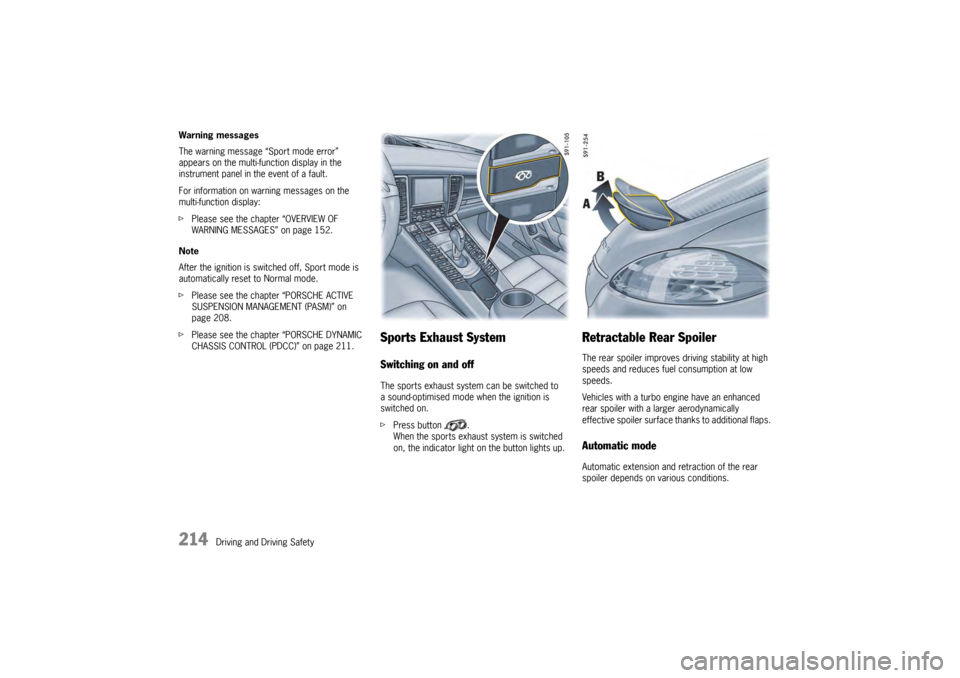
214
Driving and Driving Safety
Warning messages
The warning message “Sport mode error”
appears on the multi-f
unction display in the
instrument panel in the event of a fault.
For information on warning messages on the
multi-function display:
f Please see the chapter “OVERVIEW OF
WARNING MESSAGES” on page 152.
Note
After the ignition is switched off, Sport mode is
automatically reset to Normal mode.
f Please see the chapter “PORSCHE ACTIVE
SUSPENSION MANAGEMENT (PASM)” on
page 208.
f Please see the chapter “PORSCHE DYNAMIC
CHASSIS CONTROL (PDCC)” on page 211.
Sports Exhaust SystemSwitching on and offThe sports exhaust system can be switched to
a sound-optimised mode when the ignition is
switched on.
fPress button .
When the sports exhaust system is switched
on, the indicator light on the button lights up.
Retractable Rear SpoilerThe rear spoiler improves driving stability at high
speeds and reduces fuel consumption at low
speeds.
Vehicles with a turbo engine have an enhanced
rear spoiler with a larger aerodynamically
effective spoiler surface thanks to additional flaps.Automatic modeAutomatic extension and retraction of the rear
spoiler depends on various conditions.
Page 217 of 343
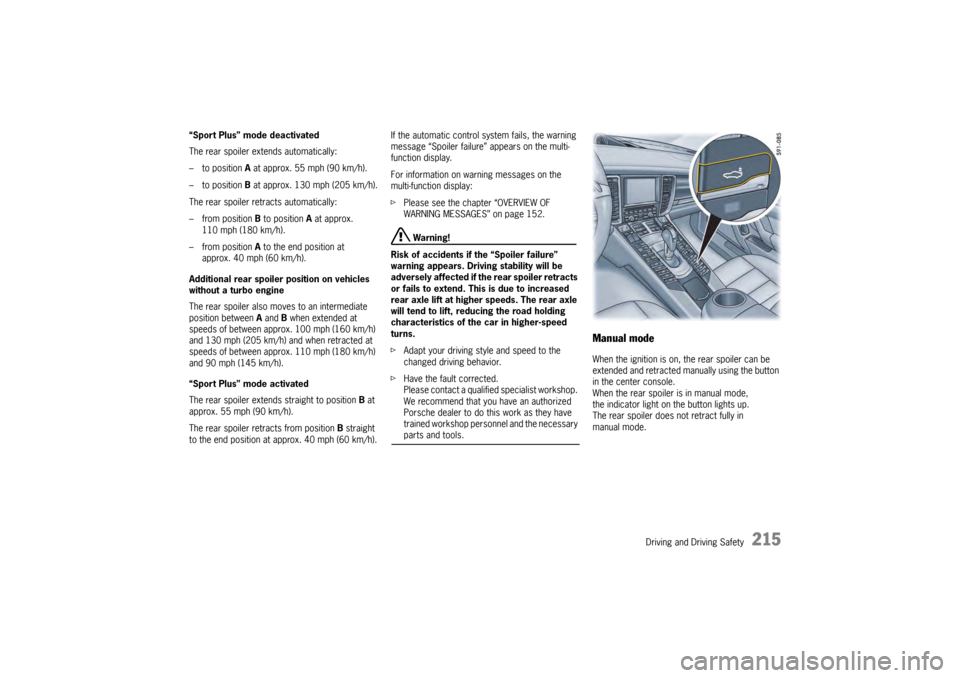
Driving and Driving Safety
215
“Sport Plus” mode deactivated
The rear spoiler extends automatically:
– to position A at approx. 55 mph (90 km/h).
– to position B at approx. 130 mph (205 km/h).
The rear spoiler retracts automatically:
–from position B to position A at approx.
110 mph (180 km/h).
–from position A to the end position at
approx. 40 mph (60 km/h).
Additional rear spoiler position on vehicles
without a turbo engine
The rear spoiler also mo ves to an intermediate
position between A and B when extended at
speeds of between appr ox. 100 mph (160 km/h)
and 130 mph (205 km/h) and when retracted at
speeds of between appr ox. 110 mph (180 km/h)
and 90 mph (145 km/h).
“Sport Plus” mode activated
The rear spoiler extends straight to position B at
approx. 55 mph (90 km/h).
The rear spoiler retracts from position B straight
to the end position at approx. 40 mph (60 km/h). If the automatic control system fails, the warning
message “Spoiler failure”
appears on the multi-
function display.
For information on warning messages on the
multi-function display:
f Please see the chapter “OVERVIEW OF
WARNING MESSAGES” on page 152.
Warning!
Risk of accidents if the “Spoiler failure”
warning appears. Driving stability will be
adversely affected if th e rear spoiler retracts
or fails to extend. This is due to increased
rear axle lift at higher speeds. The rear axle
will tend to lift, reducing the road holding
characteristics of the car in higher-speed
turns.
f Adapt your driving style and speed to the
changed driving behavior.
f Have the fault corrected.
Please contact a qualified specialist workshop.
We recommend that you have an authorized
Porsche dealer to do this work as they have
trained workshop personnel and the necessary parts and tools.
Manual modeWhen the ignition is on, the rear spoiler can be
extended and retracted manually using the button
in the center console.
When the rear spoiler is in manual mode,
the indicator light on the button lights up.
The rear spoiler does not retract fully in
manual mode.
Page 218 of 343

216
Driving and Driving Safety
Extending the rear spoiler manually
f
Press button briefly.
The rear spoiler extends to position A .
The indicator light on the button lights up.
The rear spoiler is in manual mode.
Retracting a manually extended rear spoiler
f when the vehicle is stationary
Press and hold button until the rear
spoiler has reached its end position.
The indicator light on the button goes out.
The rear spoiler is in automatic mode.
f at speeds of up to approx. 55 mph
(90 km/h)
Press button .
The rear spoiler retracts and the indicator light
on the button goes out.
The rear spoiler is in automatic mode.
f at speeds of more than approx. 55 mph
(90 km/h)
Press button .
The rear spoiler remains extended and the
indicator light on the button goes out.
The rear spoiler is in automatic mode. “Sport Plus” mode deactivated
The rear spoiler extends automatically from
position A
to position B at approx. 130 mph
(205 km/h).
The rear spoiler retracts automatically from
position B to position A at approx. 110 mph
(180 km/h).
“Sport Plus” mode activated
The rear spoiler extends automatically from
position A to position B at approx. 55 mph
(90 km/h).
The rear spoiler retracts automatically from
position B to position A at approx. 40 mph
(60 km/h).
Warning!
Risk of injury during manual retraction or
extension of the rear sp oiler when the vehicle
is stationary.
f Make sure that no pe rsons or objects are
within the range of movement of the rear
spoiler.
Risk of damage from pushing the vehicle by
the spoiler.
f Do not push the vehicl e at the rear spoiler.